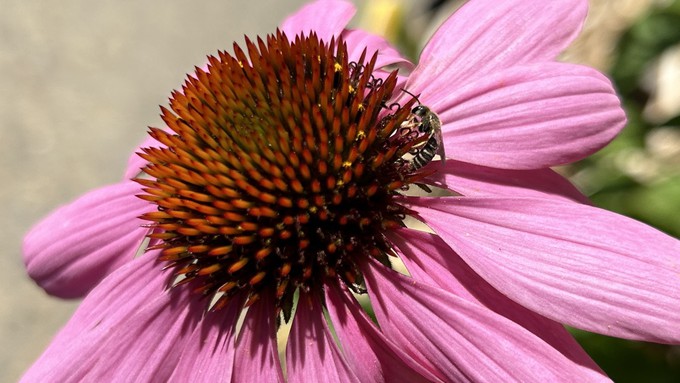
Pollinator Week celebrates and supports these crucial workers

Purple coneflowers produce both pollen and nectar, making them a favorite with bees, such as this furrow bee, part of the species of sweat bees. Kathy Morrison
What's your favorite pollinator?
If you said "bee," here's the perfect time to get specific. It's International Pollinator Week, through Sunday, celebrating and supporting pollinator health.
Honeybees are pollinators, of course, but they're not native to the Uniated States. California has more than 1,600 identified bee species -- all but a handful are native. Then of course there are flies, wasps, butterflies, bats, beetles, moths and birds that do the important work of pollinating plants and crops.
I'm fond of the little green sweat bees, but don't see them as often as I do the big lumbering carpenter bees that frequent my 'Hot Lips' salvia plant.
Whatever your favorite, pollinators are important to us. They provide one of every three bites of food we eat, according to the Pollinator Partnership, but they are threatened by urban growth, climate change and loss of habitat.
Here is the Partnership's guide for helping pollinators:
-- Plant a range of flowering plants, especially natives. (Pollinators need food through the seasons, so successful pollinator gardens always have something blooming.)
-- Reduce or eliminate your contribution to the use of pesticides. (Psst: Eliminate it! Pesticides too easily hurt the good bugs, too.)
-- Reach out to others -- inform and inspire! (Get the neighbors to plant for pollinators, too.)
-- Support local bees and beekeepers.
-- Conserve all of our resources. Use less and reduce your impact. (That organic waste bucket is being used, right?)
-- Support the work of groups promoting science-based practical efforts for pollinators.
For more information and inspiration, explore the resources at the UC Davis Bee Haven website, the Insect Connect website (part of the University of California Division of Agriculture and Natural Resources) or the Pollinator Partnership at pollinator.org
Comments
0 comments have been posted.Sacramento Digs Gardening to your inbox.
Sites We Like
Garden Checklist for week of July 21
Your garden needs you!
* Keep your vegetable garden watered, mulched and weeded. Water before 8 a.m. to reduce the chance of fungal infection and to conserve moisture.
* Feed vegetable plants bone meal, rock phosphate or other fertilizers high in phosphate to stimulate more blooms and fruiting. (But wait until daily high temperatures drop out of the 100s.)
* Don’t let tomatoes wilt or dry out completely. Give tomatoes a deep watering two to three times a week.
* Harvest vegetables promptly to encourage plants to produce more. Squash especially tends to grow rapidly in hot weather. Keep an eye on zucchini.
* Pinch back chrysanthemums for bushy plants and more flowers in September.
* Remove spent flowers from roses, daylilies and other bloomers as they finish flowering.
* Pinch off blooms from basil so the plant will grow more leaves.
* Cut back lavender after flowering to promote a second bloom.
* It's not too late to add a splash of color. Plant petunias, snapdragons, zinnias and marigolds.
* From seed, plant corn, pumpkins, radishes, winter squash and sunflowers.